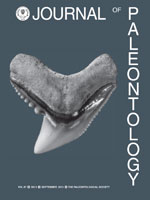The cephalopods from Union y Progreso represent the first fossil assemblage described from the Parras Shale in Coahuila, Mexico. Pseudoschloenbachia (Pseudoschloenbachia) aff. P. (P.) mexicana (Renz, 1936), P. (P.) mexicana (Renz, 1936), Baculites haresi Reeside, 1927, and Menabites (Delawarella) vanuxemi (Morton, 1830) have a geographically restricted occurrence. Didymoceras juv. sp., Menuites juv. sp., Polyptychoceras juv. sp., Pseudoxybeloceras (Parasolenoceras) juv. sp., and Scaphites sp. ex gr. S. hippocrepis (DeKay, 1828) are represented by juveniles and could not be determined to species level. Desmophyllites diphylloides (Forbes, 1846) is the only long-ranging, cosmopolitan species described from this assemblage. Three new species are described: Eutrephoceras irritilasi n. sp., Hypophylloceras (Neophylloceras) arturoi n. sp., and Tetragonites silencioensis n. sp. The morphotype Baculites n. sp. is also inferred to be distinct. The faunal composition of this assemblage indicates a late early Campanian age. This assemblage shows a high degree of endemism. The causes for this endemism are currently unknown and difficult to assess. Nevertheless, the generic composition of the Union y Progreso ammonite assemblage suggests a short-term early Campanian endemic event.
How to translate text using browser tools
1 September 2013
An Endemic Cephalopod Assemblage from the Lower Campanian (Late Cretaceous) Parras Shale, Western Coahuila, Mexico
Christina Ifrim,
Wolfgang Stinnesbeck,
José Flores Ventura
ACCESS THE FULL ARTICLE

Journal of Paleontology
Vol. 87 • No. 5
September 2013
Vol. 87 • No. 5
September 2013




